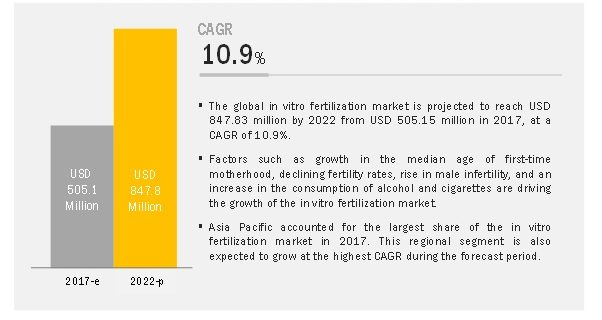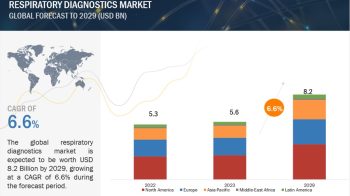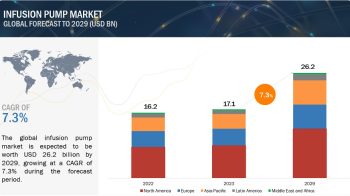
IVF market are growth of this market include growth in the median age of first-time motherhood, declining fertility rates, rising male infertility, rise in consumption of alcohol and cigarettes, and growing public awareness about infertility and the available treatment options.
In Vitro Fertilization market to grow from USD 465.2 million in 2016 to 847.8 million by 2022, at a Compound Annual Growth Rate (CAGR) of 10.9% during the forecast period. In Vitro Fertilization Market by Product (Imaging System, Incubator, Cabinets, Sperm Separation System, Cryopreservation media, Embryo Culture media), Type of Cycles & End Users (Fertility Clinics and Surgical Centres, Cryobanks).
High Cost And Low Success Rate Of The IVF Treatment
Thousands of cycles of in vitro fertilization (IVF) are performed every year, globally. However, the high cost of IVF procedures is a major factor that limits the adoption of IVF treatment. According to the Institute for Health Policy Studies, University of California, in the US, multiple births occur after 39% of IVF cycles, whereas in Europe, the figure is 26%.
The American Society for Reproductive Medicine (ASRM) lists the average price of an in vitro fertilization (IVF) cycle in the US to be USD 12,400 where the average cost of an IVF cycle with the use of fresh embryos is USD 8,158, and the median cost is USD 7,500 in the US. Moreover, the cost of the treatment drugs is also high, at an estimated USD 3,000–USD 5000 per cycle.
In addition, the probability of birth following the treatment is comparatively low. The success rate of IVF treatments is just 28% to 35%, which decreases with the age of the woman. For example, the success rate is 32.2% for women under 35, 27.7% for women aged 35 to 37, 20.8% for women aged 38 to 39, 13.6% for women aged 40 to 42, 5% for women aged 43 to 44, and 1.9% for women aged over 44 (source: BabyCenter LLC and National Health Service, UK). Owing to this, couples have to undergo multiple IVF cycles, which adds up to the overall cost of the treatment.
The cost of IVF treatment varies from country to country due to lack of reimbursement policies. Additionally, insurance companies do not generally cover the cost of infertility treatments. According to the National Infertility Association, in the US, fertility treatment is covered by only 25% of insurance plans, and many of them do not cover the expenses for the IVF treatment. In India, IVF or infertility is not considered a health issue; hence, it is not covered under general insurance. Thus, the high cost of assisted reproductive techniques to treat infertility and the lack of insurance coverage for the treatment is restraining the growth of this market.
Download PDF Brochure: https://www.marketsandmarkets.com/pdfdownloadNew.asp?id=89198891
Global IVF market has been segmented into fertility clinics and surgical centers, hospitals and research laboratories, and cryobanks. The fertility clinics and surgical centers segment is estimated to command the largest share of the global market in 2017. This segment is also projected to register the highest CAGR during the forecast period. The increasing number of fertility centers coupled with the growing infertility rates across the globe are the key factors driving the growth of the fertility and surgical centers segment.
Region Covered in IVF Market
The APAC region is expected to hold the largest share of the global in vitro fertilization market in 2017. The region is also expected to grow at the highest growth rate during the forecast period. The large share and high growth rate of the APAC region can be attributed growth in the median age of first-time motherhood, rising infertility rates, growing prevalence of PCOS, increasing incidence of obesity, the rise in fertility tourism, and government initiatives.
Europe is anticipated to be the second largest region in terms of market size in the IVF market. This can be attributed to the increasing obesity rates and PCOS in the UK, rising age of first-time pregnancy and rising obesity rates in France, declining birthrates in Germany, favorable regulatory amendments for IVF in Italy, and rise of IVF tourism in Spain.
Request for Sample Pages: https://www.marketsandmarkets.com/requestsampleNew.asp?id=89198891
Leading Companies
CooperSurgical, Inc. (US), Vitrolife AB (Sweden), Cook Medical, Inc. (US), Irvine Scientific (US), Thermo Fisher Scientific Inc. (US), EMD Sereno Inc. (US), Genea Limited (Australia), Esco Micro Pte. Ltd. (Singapore), IVFtech ApS (Denmark), The Baker Company, Inc, (US), Kitazato Corporation (Japan), Rocket Medical Plc. (UK), Hamilton Thorne, Inc. (US), Shivani Scientific (India), BIOGENICS, Inc. (US), Nidacon International AB (Sweden), Lotus Bio (Israel), Eppendorf AG (Germany), Okolab Srl (Italy), IKS International (Netherlands), Hunter Scientific (UK), Thomas Medical (US), Labotect GmbH (Germany), Shivani Scientific (India), Olympus Corporation (Japan), and RI.MOS.srl (Italy).


